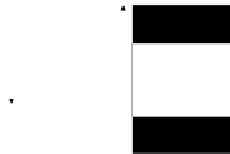Information Technology Reference
In-Depth Information
Pre-
processing
Template
Matching
Ellipse
Modelling
Lane
Locations
Morphology
Tracking
RANSAC
Fig. 1.
System overview
4 Lane Marker Detection
4.1 Preprocessing
Inverse Perspective Mapping (IPM) is used to convert a camera perspective
image to a bird's-eye view of the scene. The transformation given by
1+
1
2
r−
1
M−
1
tan
α
v
tan
θ
o
⎛
⎞
−
⎝
⎠
1
2
r−
1
M−
1
tan
α
v
X
(
r
)=
h
·
(1)
tan
θ
o
−
−
1
2
c−
1
N−
1
tan
α
u
⎛
⎞
−
⎝
⎠
1
2
r−
1
M−
1
tan
α
v
cos
θ
o
Y
(
r, c
)=
h
·
(2)
sin
θ
o
−
−
uses camera calibration parameters such as height from the ground (
h
), vertical
field of view (
α
v
), horizontal field of view (
α
u
), tilt angle below the horizon
(
θ
o
), and mage dimensions (
M
N
) to map pixels from the image plane to the
world [11]. The transformed image is converted from RGB to YCbCr to aid color
segmentation [12].
×
4.2 Template Matching
Specific dimensions for different lane markings have been defined by the Federal
Highway Administration (FHA). Normal and wide lane markers are approx. 6
inches and 10 inches wide respectively. Double lane markers consist of two normal
lane markers with a gap in between. [13]. Templates shown in Fig. 2 are created
with equivalent dimensions in the IPM image and used for matching.
(a)
Double
(b)
Normal
(c)
Wide
marker.
marker.
marker.
Fig. 2.
Lane marker templates and their dimensions
Template matching is performed using Normalized Cross Correlation (NCC).
At first, a binary image is obtained by application of a high threshold
τ
High
on










































Search WWH ::

Custom Search